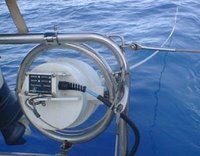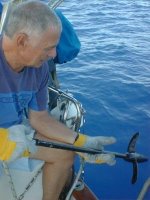Aquair 100 in Australia on SY PINDIMARA
Hi David
I just thought that I would update you with our progress. I knocked the bearing seal back into place with a soft hammer, replaced the bent clevis pin, and reassembled the air turbine with the new boss. The propeller slipped into place with ease and I hoisted it onto the foredeck. The only complaint that I have is that it is very hard to get one of the tail fin bolts into place, because it butts right up against the cable and you need very small fingers while balanced on a swaying deck.
We then waited through a week of perfect calm with no wind at all.
Finally, a storm blew up and the generator started spinning. Over the next week or so we had quite a few thunderstorms, and we were gratified to see a reasonably steady 1 to 6 amps flowing into our system. In fact, for the first time ever, during a particularly big storm, I noticed that the Ampair regulator (which also takes power from our solar panels) was actually shutting down with an indicated battery voltage of just over 13 volts. We'd never had a full charge before, and this made us very happy.
The turbine hangs directly above our forepeak cabin, perhaps four metres above our bed. We had been worried about the noise (in fact, everybody in the marina started grumbling when they saw us mounting a wind generator) but found that even in the middle of the night we couldn't hear the Ampair over the slight rumble of our tiny Nicro extractor fan. In fact, we occasionally shut the extractor down to see if we could hear the Ampair turning, but the most we got was a slight "thwuck thwuck" at low speed and just a gentle "whoosh" when up to generating speed. Then in one particularly fierce storm, the wind changed to a southerly (those are the evil cold Antarctic winds here) and started to moan in the shrouds, and we suddenly heard the turbine start to howl. I rushed up on deck to have a look, and then realised to my amusement that the Ampair (now an all-but invisible blur in the starlight) was still completely silent; all the noise was coming from a pole-mounted generator on another yacht 40 metres away.
So you can colour us very impressed. Now we just need to sort out the tow mounting, but for that we need to get out of the estuary and into the sea (it's too crowded and shallow to tow a line inshore here) and we haven't yet had the chance. Maybe this coming weekend.
Thanks for a great, solidly built piece of kit.
Reinhard
These clients are using the Ampair regulator with the dual wind + solar input. The particular model that they are using is the DM1B-12 where the D indicates dual input. These Ampair charge control regulators are four stage PWM regulators which were well in advance of most other regulators when they were introduced about 15-years ago. Now they are simply as good as others and I guess they are due for a refresh at some point.
You must be careful which regulator you use with a wind turbine and ordinarily you should not try to use a solar regulator with a wind turbine to save money. This is because a common solar regulator is intended for quite low voltages (say max 20V for a 12V regulator, or max 40V for a 24V regulator) and wind or water turbines can give much higher voltages when being controlled. The higher voltages will damage the low cost components used in most solar regulators. This is why turbine manufacturers design and manufacture their own regulators which are that bit more expensive because they have higher grade components.
Labels: Aquair 100 as a wind generator using hoist in rigging kit


